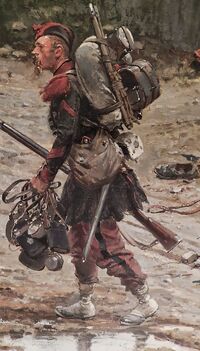National Anthem of Gaulan
 "The Tired Veteran" painted by Hubert d'Espèrey | |
National anthem of Union de Gaulan | |
| Also known as | La marche des Gaulois (English: March of the Gaulois) |
|---|---|
| Lyrics | Unknown |
| Music | Henri Langlais, 1848 |
| Adopted | 1855 |
"La marche des Gaulois" is the Gaulois name for the traditional ballad which has been the national anthem of Gaulan since 1855 CE when it was adopted in the aftermath of both the Merlot Mutiny and the Long War. It remains the only national anthem in Amuria that does not have any lyrics, though unofficial lyrics are occasionally used
History
For much of its history, Gaulan had gone without an official national anthem, this being a result of both refusal by the Gaulois Kings, who often deemed the music prepared for them of poor quality and insulting, often insisting on the usage of The Anointed One to be played in their presence, which concerned itself more with the glory of the Kings themselves rather than the nation. As suchThe Anoited One was used at state occasions in place of any sort of national one and the chosen anthem often had changing lyrics, due to the meddling of reigning Kings who added verses for themselves, to the point the anthem became nearly 30 stanzas long. The lack of a national anthem was also partly a result of a perceived lack of a need for one; militarily speaking each regiment and ship-of-the-line had its own traditional anthems which were performed or sung at special occasions, while on occasions of multiple units marching together, a single drum beat was used to keep the pace and step.
At the outset of the Long War in 1840, an increase of songs regarding anti-Monarchical subjects began to rise in popularity, especially among the Republican militias, with many militias, like that of the Monarchical forces, designing their own songs. Music became such an important factor of the war, that towns would play the anthem of a unit to show which side they displayed loyalty to, however the large array of possible songs led to some instances of rebel forces attacking their own towns as they didn't recognise the sound of their own music. As such, Henri Langlais was commissioned by the Republican League to create a unifying piece of music for the Republican forces to play, to prevent similar attacks on friendly forces, leading to the creation of the March of the Gaulois, which proved popular with both soldiers and civilians.
The song gained international prominence during the Merlot Mutiny, which saw the Household Guard regiments rebel against their continued service with the Crown. Arresting the King, they executed him as the Rebel song was playing in the background. The connection to the removal of the Monarchy eventually led to the March being officially adopted by the first Republican Congress as the National Anthem.
Laws and Etiquette
The Anthem Act of 1900 specifies the drumbeat of "La marche des Gaulois", placing the song in the control of the National League of the Infirmaries, who permission is required from to play at events. However, the League rarely enforces infringement and often only requires a small payment of a single Florin to play the anthem, to which the Florin is used to pay for hospital care. The League of specifically allows for the playing of the anthem by military units for free and without the need for approval.
When performed at events, traditional etiquette is to either begin or end the ceremony or event with the playing of the anthem and for the audience to stand for the playing of the anthem. Civilian men typically remove their hats, while women and children are not required to do so. Military men and women in uniform traditionally keep their hats on and stand in military salute for the duration of the performance of the anthem, with the salute offered in the direction of the national flag if one is present. If a national flag is not present, military men and women traditionally offer the military salute while standing at attention. At the conclusion of the anthem, it is customary for the men to remove their hats and throw them in the air, followed by a resounding cheer. This is act was inspired by the reaction of the soldiers following the Merlot Mutiny who threw their hats in the air in celebration of victory.
"La marche des Gaulois" is traditionally performed first when the event is hosted in Gaulan.